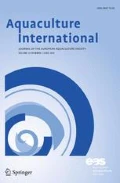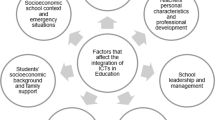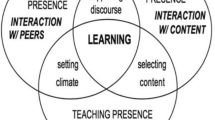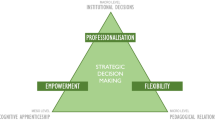Abstract
In this paper, we investigate the potential changes that education innovation can bring to education and training in aquaculture. When introducing Information and Communication Technology methods into new educational contexts, situations and/or practices, in the process teacher/practitioners will almost always make use of innovatory technology which in itself can lead to a measure of change within the relevant educational system. Nevertheless, it should not be forgotten that the use of technology is not an end in itself, its use is only justified as a tool to achieve the educational goals that have been set. It is in this spirit that two case studies are presented from current aquaculture curricula, which make use of innovative teaching methodology in the form of e-Learning: one case study is from the Open University (Universidade Aberta) in Portugal [distance teaching in a Master’s programme (Second Cycle)]; the second is from the NAFC Marine Centre, Scottish Qualifications Authority accredited courses in Scotland, UK. We report the pedagogical models on which these courses were built, the tools required to achieve the intended educational objectives and the teaching and learning resources used. We also report the creative stimulus inherent in the innovation processes that allowed the two teachers/instructors to achieve the same, or better, results than traditional teacher-led classroom methods, by using a technology-enhanced teaching process without the need for face-to-face interaction.
Similar content being viewed by others
Abbreviations
- FAO:
-
UN Food and Agriculture Organisation
- ICT:
-
Information and Communication Technology
- IT Staff:
-
Information Technology Staff
- HE:
-
High Education
- LMP:
-
Learning Management Platform
- PDF:
-
Portable Document Format
- SCORM:
-
Sharable Content Object Reference Model
- SQA:
-
Scottish Qualifications Authority
- WebCT:
-
Web Course Tools
References
Anderson A, Elloumi F (eds) (2008) Theory and practice of online learning. Athabasca University, Athabasca. http://www.aupress.ca/index.php/books/. Accessed 5 Dec 2010
Biasutti M (2011) The student experience of a collaborative e-learning university module. Comput Educ 57:1865–1875. doi:10.1016/j.compedu.2011.04.006
David PA (1990) The dynamo and the computer: an historical perspective on the modern productivity paradox [Electronic edition]. Am Econ Rev 80(2):355–361. http://www.compilerpress.atfreeweb.com/Anno%20David%20The%20Dynamo%20and%20the%20Computer%20An%20Historical%20Perspective%20on%20the%20Modern%20AER%201990.htm
Demos (2004) Report of the learning working group ‘learning to learn’. http://www.demos.co.uk/search?q=learning+to+learn. Accessed 16 May 2009
FAO (2011) World aquaculture 2010. FAO Fisheries and Aquaculture Department. Technical Paper 500(1). Rome, FAO, pp 105. http://www.fao.org/docrep/014/ba0132e/ba0132e00.htm
Fleischmann K (2013) Big Bang technology: what’s next in design education, radical innovation or incremental change? J Learn Des 6(3):1–17
Fullan M (2007) The new meaning of educational change, 4th edn. Teachers College Press, Columbia University, New York
Groff J (2013) Technology-rich innovative learning environments. OECD CERI Innovative Learning Environment project
ITL Research (2011) Innovative teaching and learning research—findings and implications. ITL Research—Innovative Teaching and Learning
Joint Information Systems Committee (2008) Effective practice with e-Portfolios. http://www.jisc.ac.uk/media/documents/publications/effectivepracticeeportfolios.pdf
Joint Information Systems Committee (2014) Introduction to e-Learning. http://www.jiscdigitalmedia.ac.uk/guide/introduction-to-elearning. Accessed 14 Feb 2014
Katuk N, Kim JH (2013) Experience beyond knowledge: pragmatic e-learning systems design with learning experience. Comput Hum Behav 29:747–758. doi:10.1016/j.chb.2012.12.014
Livingstone I, Matthews H (2000) Assessing and recording a skills-based curriculum. Cheltenham, Geography Discipline Network (GDN)
MClaughlin MW, Mitra D (2001) Theory-based change and change-based theory: going deeper, going broader. J Educ Change 2(4):301–323. doi:10.1023/A:1014616908334
Nicol D, Macfarlane-Dick D (2006) Formative assessment and self-regulated learning: a model and seven principles of good practice. http://www.reap.ac.uk/public/Papers/DN_SHE_Final.pdf. Accessed 10 March 2009
Oblinger DG, Oblinger J L (eds) (2005) Educating the Net Generation, An Educause ebook publication. http://net.educause.edu/ir/library/pdf/pub7101.pdf. Accessed 5 Jan 2013
OECD (2010) Inspired by technology, driven by pedagogy: a systemic approach to technology-based school innovations. OECD-Organisation for Economic Co-operation and Development: Centre for Educational Research and Innovation
Palacios-Marqués D, Cortés-Grao R, Carral C (2013) Outstanding knowledge competences and web 2.0 practices for developing successful e-learning project management. Int J Project Manage 31(1):14–21. doi:10.1016/j.ijproman.2012.08.002
Peacock S, Murray S (2009) Learners’ initial expectations and experiences of ePortfolios: a pilot study. eJ Learn Teach 2(4). ISSN 1744-7747. http://bejlt.brookes.ac.uk/Brookes. Accessed 15 Jan 2014
Pereira A, Mendes A, Morgado L, Amante L, Bidarra J (2008) Universidade Aberta’s Pedagogical Model for Distance Education. A University for the future. Universidade Aberta, Europress
Prensky M (2001) Digital natives, Digital immigrants part 1. Horiz 9(5):1–6
Saadé R, Morin D, Thomas J (2012) Critical thinking in e-learning environments. Comput Hum Behav 28(5):1608–1617. doi:10.1016/j.chb.2012.03.025
Seixas S, Bostock J, Eleftheriou M (2012) Promoting sustainable aquaculture: building the capacity of local institutions and online teaching (elearning). Manag Environ Qual 23(4):434–450. doi:10.1108/14777831211232245
Sergiovanni TJ (2000) Leadership for the schoolhouse—How is it different? Why is it important?. Jossey-Bass, San Francisco
Shetland News (2013) Shetland’s worth £1.1 billion. http://www.shetnews.co.uk/news/6842-shet. Accessed 23 May 2013
Siemens G, Tittenberge P (2009) Handbook of Emerging Technologies for Learning. http://elearnspace.org/Articles/HETL.pdf. Accessed 14 Feb 2013
TACCLE (2009) TACCLE—teachers’ aids on creating content for learning environments: the e-learning handbook for classroom teachers. GO! onderwijs van de Vlaamse gemeenschap, Brussel, p 130
Wang Y (2012) Education in a changing world: flexibility, skills, and employability. The World Bank, Washington
World Bank (2011) Learning for all: investing in people’s knowledge and skills to promote development. World Bank Group Education Strategy 2020, Washington
Acknowledgments
The authors wish to acknowledge ‘Margaret Eleftheriou’.
Author information
Authors and Affiliations
Corresponding author
Rights and permissions
About this article
Cite this article
Seixas, S., Saravanan, S. & Gonçalves, S. Innovation and educational changes: two e-Learning cases in aquaculture. Aquacult Int 23, 843–859 (2015). https://doi.org/10.1007/s10499-014-9850-y
Received:
Accepted:
Published:
Issue Date:
DOI: https://doi.org/10.1007/s10499-014-9850-y




